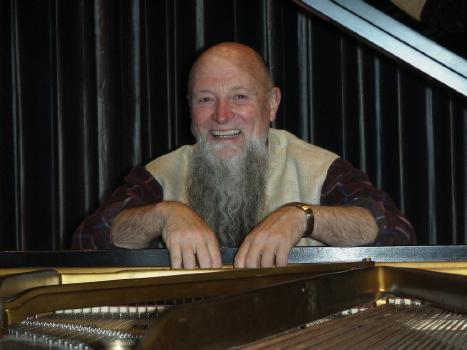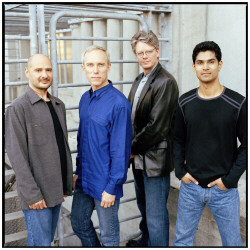Kronos performs dreamy plasma at Stanford
In 2001 the Kronos quartet was contacted by NASA to see if the group was interested in “the sounds of space,” recordings of plasma waves from spacecraft. A plasma is a gas so hot that its electrons have been separated, transforming the neutral gas into a sea of charged ions. Our solar system is filled with a tenuous plasma, a solar wind that laps at the shores of worlds and interacts with planetary magnetic fields.
Working with physicist Don Gurnett, who built the plasma-wave receivers for NASA, they approached composer Terry Riley to create a piece for string quartet based on the recordings. Local icon Riley, a minimalist composer who inspired the generation of Philip Glass and John Adams, is also an accomplished Indian vocalist. Sun Rings, his 90-minute multimedia composition for string quartet, choir, electronics and video was the result, a compelling fusion of classical, jazz and raga.
Performed at Stanford’s Memorial Hall last Saturday, Jan. 18, by the Kronos Quartet along with the Stanford Chamber Chorale, it displays a careful crafting of nature and art, a polished and meditative work.
The forces that shape our world–sun, rain and wind, along with
surface tension, Coriolis force, and lunar tides–interact in complex
ways to form mountains, coastlines, the strange fractal patterns around us. Shaping life, these forces lend us insight into these iterative functions. The thunder and hiss of waves, undertow’s rhythmic suck, a sculpted sand dune, and the gentle curve of a breast. We know these truths within us, and when we hear the wail and spatter of plasma there is a familiarity, an instinctive knowledge that we are of one pattern with it.
Written in 10 movements, Sun Rings opens with the mechanically distorted voice of “ground control,” syllables abrupt and squared off, against a background of electronically modulated plasma waves. A tabla begins to beat, and the plasma waves take on the sounds of Indian raga.
The four members of Kronos sit on a darkened stage, shapes backlit by a grainy video feed from space. The muffled thunder of hot exhaust becomes a deep note in the score. In a curious reversal, the artifacts of humankind–boxy Voyager, mechanical chirps, digitized counting–become alien, while plasma resonates with life, a chorus of chattering mynah birds.
Long bowed notes move into playful gypsy phrases. Shifting from an Eastern bebop, the chords open up, sad and Coplandesque. Clash of distant trash cans punctuate them, waves bunching up away from Earth.
A women’s chorus enters with Sufi chanting in a meditative whole-tone scale, nonsense syllables pure and exultant. Energetic viola echoes them, then parses electronic grumblings and whistles as musical language.
The plasma encircling Jupiter develops new sounds: rain tubes filled with fresh electrons, eerie screams and blubbery notes, twang of mouth harp, a whale singing to the ocean. The stage lights shift from the deep blue of near space to crimson as the emotional tone changes.
Riley, composing this piece in 2001, was deeply affected by the events of 9/11 and leaves his serene outward focus for a long-range view of Earth. The “Prayer Central” movement milks the full chorus for a sound both holy and personal, an entreaty for peace.
He ends with deep cello, a Barber-like elegy, and the looped recorded voice of Alice Walker, from Sept. 12, 2001, “One earth…one people…one love.”
The slow applause marked the breaking of a trance, Riley’s vision and prayer of wholeness.
—Adam Broner
Originally published in the Piedmont Post
Photo of Kronos Quartet by Jay Blakesberg
